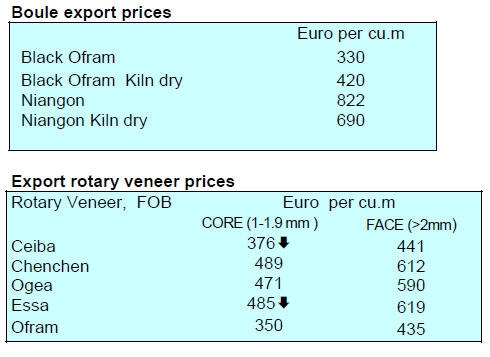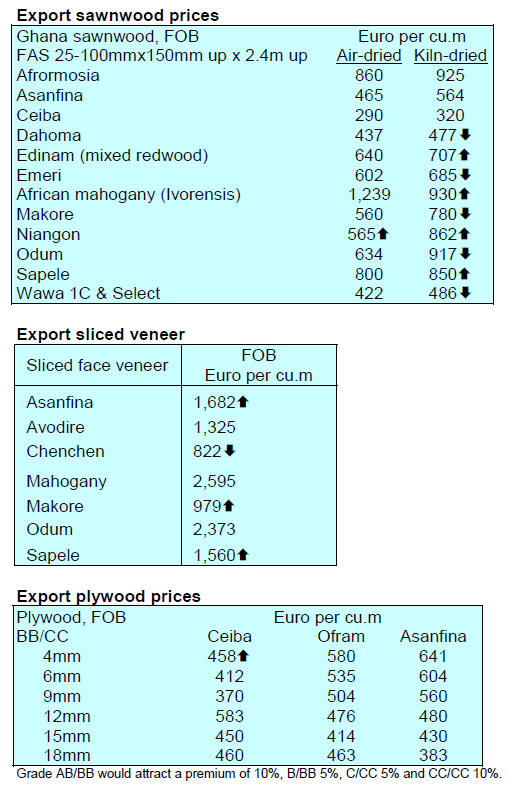|
1.
CENTRAL AND WEST AFRICA
Harvesting and trucking conditions good
Heavy rains continue to disrupt harvesting and milling in
Cameroon, fortunately the dry season is approaching when
mills can ramp-up production. Producers report order
levels as satisfactory for the next 2 months but face a
problem getting shipments sent.
It is not only in Cameroon that the weather is a problem, in
the DRC the trucking of logs and shipment of sawnwood
are disrupted by the rain which makes many roads
impassable. The other problem reported is that there has
been a rise in the number of illegal road blocks where
money has to be paid before trucks can proceed. The DRC
exports mainly iroko, sapelli, doussie and sawn ayous,
sapelli, sipo and moabi.
In other news, in Gabon it is reported that stocks of unsold
okoume logs in the central log park of the GSEZ special
zone has risen to about 40,000 cu.m as the Indian veneer
mills have lowered production awaiting an end to the rain
season when log prices drop as harvesting and trucking
problem ease.
Operators in Gabon continue to complain that it takes a
very long time to get documents processed by the forestry
ministry.
Invitation to join Commonwealth Organisation
Gabon and Togo are the latest countries invited to join the
Commonwealth, a little unusual as both countries are
former French colonies. Recently, Patricia Scotland,
Secretary General of the Commonwealth Secretariat held
discussions with Lee White, Gabon’s Minister of Forests,
Oceans, Environment and Climate Change.
She commented that Gabon’s forestry, marine protection,
climate mitigation and carbon-neutral policies had enabled
the country to achieve impressive milestones in
biodiversity and environmental governance.
See:
https://associatestimes.com/csg-patricia-scotland-meetsforests-minister-of-gabon-prof-lee-white-cbe/
New initiative by France
In late July French President Emmanuel Macron began a
tour of Central African countries beginning with
Cameroon where he spoke of the “exceptional nature of
the friendship between our two countries”.
The purpose of the visit was reportedly to diversify
collaboration beyond infrastructure and to include
agriculture, technology, creative industries and sport.
Many in Cameroon see this visit as an attempt to counter
the influence of China who has a major presence in the
timber sector.

2.
GHANA
First half year exports
In the first half of 2022 cumulative export of wood
products amounted to 165,630 cu.m earning euro 71.61
million. This compared to 145,486 cu.m in the same
period in 2021 when euro 70.56 million was earned.
Comparative figures for various export products are
tabulated below.

Air-dried sawnwood (84,245 cu.m), kiln-dried sawnwood
(22,353 cu.m) and billets (20,535 cu.m) accounted for
51%, 13% and 12% of the total first half export volume.
The export of plywood (4,346 cu.m) and air-dried boules
(1,320cu.m) exceeded those in the first half of 2021 by a
big margin.
Plywood exports to regional markets were significant and
have been so since the beginning of 2022 with a 68%
volume increase to 18,668 cu.m in the first half of 2022
from 11,123 cu.m recorded in the previous first half year.
The total volume of the three leading products during the
period under consideration was 24,334 cu.m, representing
15% of 2022 total exports against 12,853 cu.m or 9% in
2021.The markets for these products included Senegal,
Togo, Burkina Faso, Niger, Greece and Germany with
species shipped including ceiba, gmelina and mixed red
wood.
The Timber Industry Development Division (TIDD) data
also showed that the number of exporters in the industry
increased from 89 in 2021 to 98 in the first half of 2022.
Bold measures needed to drive domestic
manufacturing
The Association of Ghana Industries (AGI)) has called on
government to take bold and decisive measures aimed at
promoting the local manufacturing of products to reverse
the current economic crisis facing the country.
This was the proposition made by the AGI President, Dr.
Humphrey Ayim-Darke, when speaking at the 5th Edition
of the Ghana Industrial Summit and Exhibition 2022, on
the theme ‘Investing in Ghanaian Industries to Leverage
opportunities in the Single African Market’.
He said investment by government in the local industries
is the surest way the country can come out of its current
challenges.
For the future Dr. Humphrey urged the government to
create a business enabling environment through dedicated
policies and programmes for businesses in the country can
thrive and expand into the AfCFTA regional and
international markets.
Minister for Trade and Industries, Alan Kyerematen,
assured the AGI of government’s efforts through its
various flagship programmes to promote the country’s
economic transformation and industrialisation.
See:
https://gna.org.gh/2022/08/agi-calls-for-aggressive-localproduction-to-dampen-economic-downturn/
Ghana to start trading in AfCFTA
Ghana and seven other countries including Kenya, Egypt,
and Cameroon have agreed to begin trading under the
African Continental Free Trade Agreement (AfCFTA).
The Deputy Minister of Trade and Industry, Herbet Krapa,
disclosed this at a seminar organised by the Africa Export
and Import (Afrexim) Bank for trading companies in the
country.
In related news, the World Bank’s ‘Ghana Trade
Competitiveness Diagnostic Report to 2035”, says the
AfCFTA trade in goods and services can boost Ghana’s
real income by 5.7%. This represents around two third of
the Ghana’s AfCFTA income boost from trade facilitation
measures while reductions in Non-Tariff Barriers (NTBs)
will account for almost 2% along with reduction of tariffs.
AfCFTA represents a major opportunity for African
countries to boost growth. Some of the countries
partnering with Ghana to begin the AfCFTA trading
already import wood products such as sawnwood, sliced
veneer and plywood from Ghana.
See:
https://www.myjoyonline.com/ghana-7-others-to-beginactual-trading-under-afcfta/
 
3. MALAYSIA
First
half 2022 exports encouraging but slower growth
anticipated
Ministry of Plantation Industries and Commodities has
released export data which shows timber sector exports
rose by 14% to RM13.2 billion between January and June
2022, against RM11.59 billion for the same period last
year.
The sector’s export value reached RM22.7 billion in 2021
with wooden furniture being the most important
component, contributing RM10.4 billion.
Malaysian wood-based furniture are exported to more than
160 countries of which the main markets are the United
States, Japan, Singapore, Australia, and the United
Kingdom. However, Malaysia’s trade performance is
showing signs of a slowdown with uncertainties in the
global economic landscape starting to take its toll.
The Borneo Post has quoted a report from the RHB
Investment Bank which says the Bank sees signs of slowdown
in the growth momentum of exports to major
economies.
The report says some global indicators point to a slower
global growth, for example, the global manufacturing PMI
has fallen to a two-year low and the official manufacturing
PMI for China has contracted steadily as the country faces
sporadic covid lockdowns.
See:
https://www.theborneopost.com/2022/08/21/malaysiastrade-showing-signs-of-a-slowdown/
Issue of migrant workers wellbeing to be addressed
In a press release the Malaysian Timber Council (MTC)
has taken a step forward in addressing the risk of forced
labour in the timber sector to show its commitment
towards human rights and upholding labour standards.
A seminar on the effective management of migrant
workers, titled “Enhanced Social Compliance Practices in
Employment of Migrant Workers in the Malaysian Timber
Industry” was addresses by migrant worker rights
specialist, Andy Hall, as a keynote speaker together with
Arulkumar Singaraveloo, who is the co-founder of the
Malaysia Human Right Forum.
“The issue of migrant workers and their well-being is of
concern to the MTC said MTC CEO Muhtar Suhaili. Andy
Hall said “this seminar was an important step forward for
the Malaysian timber industry. Challenges revolving
around migrant workers welfare and prevention of forced
labour will increasingly become mandatory for doing
business globally.
See:
https://mtc.com.my/images/media/1258/Msian_Tmber_Industrys_Commitment_Towards_Better_Migrant_Workers_Managemen
t.pdf
Strengthening cooperation on SFM
The Sabah media has reported that the State government
plans to amend the Forest Enactment 1968 Act to ensure
the State’s forestry legal framework is in line with the
National Forestry Act (APN) 1984 which was passed by
the central government recently.
| 
